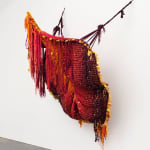-
Artworks
Kira Dominguez Hultgren USA, b. 1980
To Carry Every Name but Your Own, 2022Handspun ropes in sisal, silk, bullet-proof and stab-proof Kevlar; warped in wool, acrylic, cotton, linen, silk; loom bars; zip ties96 x 60 x 40 in
243.8 x 152.4 x 101.6 cmCopyright The ArtistFurther images
-
(View a larger image of thumbnail 1
)

-
(View a larger image of thumbnail 2
)

-
(View a larger image of thumbnail 3
)

-
(View a larger image of thumbnail 4
)

-
(View a larger image of thumbnail 5
)

-
(View a larger image of thumbnail 6
)

-
(View a larger image of thumbnail 7
)

-
(View a larger image of thumbnail 8
)

-
(View a larger image of thumbnail 9
)

This year I celebrated my 20th wedding anniversary with purple and orange calla lilies, the same flowers I carried down the aisle at my wedding in 2002. In considering Luz...This year I celebrated my 20th wedding anniversary with purple and orange calla lilies, the same flowers I carried down the aisle at my wedding in 2002. In considering Luz Jiménez (1897-1965, Milpa Alta, Mexico), “The Mexican Flower Seller,” so-titled by Diego Rivera when he painted Jiménez holding calla lilies in the 1940s, I wanted to weave a piece that interrogated the symbol and contexts of what it means for me to hold calla lilies after Jiménez, after Rivera. Beyond calla lilies, I’m also exploring what it means to be held by contemporary fiber art/weaving/feminism/motherhood after Jiménez, after Rivera, who painted Jiménez as “The Weaver,” after Jean Charlot who sculpted Jiménez as “Motherhood,” after Tina Modotti who photographed Jiménez as a revolutionary and feminist.
In U.S. contemporary art, the fiber feminists of the mid 20th-century, such as Magdalena Abakanowicz, Lenore Tawney, and Françoise Grossen, wove (wall) sculptures to challenge not just the language surrounding the female body in art history and institutions, but to reclaim the image and ownership of their bodies – to tell their story, their way in sisal and jute. In 1981, Chicana artists and activists Cherrie Moraga and Gloria Anzaldua’s anthology, The Bridge Called my Back: Writings by Radical Women of Color furthered the idea that brown and black women must continuously act as go-betweens, living in the fringes of so many different worlds, having to translate between and hold the stories for communities that wouldn’t find one another except through the presence of these (what we would call in 2022) intersectional identities.
To bring these narratives together, Kevlar lines the inside of this piece, shredded in the weaving process, torn on the loom by the mohair and silk in the warp.
But while this history and material surrounds me, holds me, carries me, I wonder if it isn’t Punjabi phulkari embroidery and Mrinalini Mukherjee's fiber deities that are most influencing the color and composition of this piece?Provenance
To Carry Every Name but Your Own, Eleanor Harwood Gallery, San Francisco CA, September 10 to October 22, 2022Exhibitions
To Carry Every Name but Your Own, Eleanor Harwood Gallery, San Francisco CA, September 10 to October 22, 2022 -
(View a larger image of thumbnail 1
)









